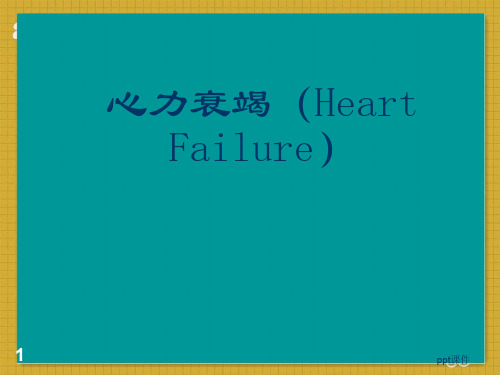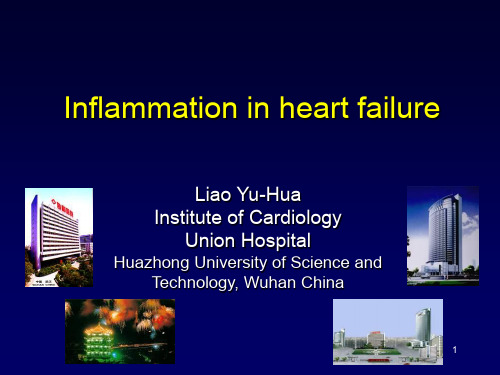全英文心衰PPT讲课稿
合集下载
心衰完整课件PPT课件

心衰时线粒体结构和功能异常,影响 氧化磷酸化过程和ATP生成。
心肌能量底物利用障碍
心衰时心肌对葡萄糖、脂肪酸等能量 底物的利用障碍,导致ATP生成减少 。
临床表现与诊断方
03
法
典型临床表现
呼吸困难
劳力性呼吸困难、夜间阵发性呼吸困难、端坐呼吸等。
乏力、运动耐量下降
心衰患者常出现乏力、运动耐量下降等症状。
强、外周血管收缩等。
肾素-血管紧张素-醛固酮系统激活
02
心衰时该系统过度激活,导致水钠潴留、血容量增加、血压升
高。
炎症因子释放
03
心衰时炎症因子如TNF-α、IL-6等释放增加,进一步加重心肌
损伤和心功能恶化。
心肌能量代谢障碍
心肌缺血缺氧
线粒体功能障碍
心衰时心肌血流灌注不足,导致心肌 缺血缺氧,影响心肌能量代谢。
量。
降低死亡率
通过积极的治疗措施,降低心 衰患者的死亡率,延长生存期 。
预防并发症
积极控制心衰的危险因素,预 防并发症的发生,如心律失常 、血栓形成等。
个体化治疗
根据患者的具体情况,制定个 体化的治疗方案,以达到最佳
的治疗效果。
药物选择及作用机制
利尿剂
通过促进肾脏排钠排水,减轻心脏前负荷,缓解水肿症状。常用药物 包括呋塞米、氢氯噻嗪等。
心肌细胞损伤
心肌细胞坏死或凋亡,导致心肌 收缩力下降。
心脏结构改变
心脏扩大、心室壁变薄、心脏瓣膜 关闭不全等,影响心脏泵血功能。
心脏舒缩功能障碍
心肌顺应性降低、舒张期压力-容积 曲线左移,导致心室充盈受限。
神经内分泌系统激活
交感神经系统兴奋
01
心衰时交感神经系统过度激活,导致心率加快、心肌收缩力增
心力衰竭英文课件

且能和同龄儿一样活动。
II级(轻度心衰):体力活动轻度受限。一般活动可引起疲 乏、心悸活呼吸困难。学龄儿童能够参加体育课,但活动量 比同龄儿童小。可能存在继发性生长障碍。
III级(中度心衰):体力活动明显受限。少于平时活动即出 现症状(如步行15分钟),学龄儿童不能参加体育活动,存 在继发性生长障碍。
治疗
洋地黄类药物:正性肌力,负性传导,负性心率; 直接抑制过度的神经内分泌系统。
临床常用制剂:地高辛;西地兰。 常 用 剂 量 : 地 高 辛 口 服 化 量 : < 2 岁 0.05-
0.06mg/kg,>2岁0.03-0.05mg/kg,维持量为 化 量 的 1/5 。 西 地 兰 静 注 化 量 : < 2 岁 0.030.04mg/kg,>2岁0.02-0.03mg/kg。
计分
1
2
头部及躯干(活动时) 头部及躯干(安静时)
较多
常有
吸气凹陷
呼吸困难
50-60 35-45 25-35 18-28 160-170 105-115 90-100 80-90 2-3cm
>60 >45 >35 >28 >170 >115 >100 >90 >3cm
注:0-2分无心衰;3-6分轻度心衰;7-9分中度心衰;10-12分重度心衰。
新生儿用量更少,取婴儿量的1/2至2/3。
治疗---洋地黄类药物
使用方法
化量(饱和量):适用于急性心衰或重症心衰, 首次用化量的1/2量,余量分2次(1/4、1/4), q4h-q6h或q8h。 维持量:适用于慢性心衰或轻症心衰,维持量 为化量的1/5量,分2次口服;或者化量后需继 续维持者,于化量后12小时开始予维持量。
治疗---洋地黄类药物
II级(轻度心衰):体力活动轻度受限。一般活动可引起疲 乏、心悸活呼吸困难。学龄儿童能够参加体育课,但活动量 比同龄儿童小。可能存在继发性生长障碍。
III级(中度心衰):体力活动明显受限。少于平时活动即出 现症状(如步行15分钟),学龄儿童不能参加体育活动,存 在继发性生长障碍。
治疗
洋地黄类药物:正性肌力,负性传导,负性心率; 直接抑制过度的神经内分泌系统。
临床常用制剂:地高辛;西地兰。 常 用 剂 量 : 地 高 辛 口 服 化 量 : < 2 岁 0.05-
0.06mg/kg,>2岁0.03-0.05mg/kg,维持量为 化 量 的 1/5 。 西 地 兰 静 注 化 量 : < 2 岁 0.030.04mg/kg,>2岁0.02-0.03mg/kg。
计分
1
2
头部及躯干(活动时) 头部及躯干(安静时)
较多
常有
吸气凹陷
呼吸困难
50-60 35-45 25-35 18-28 160-170 105-115 90-100 80-90 2-3cm
>60 >45 >35 >28 >170 >115 >100 >90 >3cm
注:0-2分无心衰;3-6分轻度心衰;7-9分中度心衰;10-12分重度心衰。
新生儿用量更少,取婴儿量的1/2至2/3。
治疗---洋地黄类药物
使用方法
化量(饱和量):适用于急性心衰或重症心衰, 首次用化量的1/2量,余量分2次(1/4、1/4), q4h-q6h或q8h。 维持量:适用于慢性心衰或轻症心衰,维持量 为化量的1/5量,分2次口服;或者化量后需继 续维持者,于化量后12小时开始予维持量。
治疗---洋地黄类药物
心衰完整课件PPT课件

心衰的诊断与评估
心衰的诊断标准
存在引起心衰的病因,如冠心病、高 血压、心脏瓣膜病等。
辅助检查显示心功能不全,如心脏扩 大、心脏收缩或舒张功能减低等。
有心衰的症状和体征,如呼吸困难、 乏力、液体潴留等。
心衰的评估方法
病史采集
了解患者的症状、既往史、家 族史等。
体格检查
观察患者的生命体征、心肺听 诊等。
01
心衰的治疗与管理
心衰的一般治疗
休息与活动
饮食调整
根据心衰的严重程度和医生的建议,合理 安排休息与活动,避免过度劳累。
限制钠盐摄入,控制液体摄入量,保持低 盐、低脂、高蛋白的饮食习惯。
体重监测
心理支持
每日监测体重,保持稳定水平,如有异常 及时就医。
心衰患者容易出现焦虑、抑郁等情绪问题 ,家属和医护人员应给予心理支持和疏导 。
实验室检查
检测血液中的生化指标,如 BNP或NT-proBNP。
器械检查
心电图、超声心动图、核素心 功能检查等。
心衰的鉴别诊断
01
鉴别心衰与其他原因引 起的呼吸困难、乏力等 症状。
02
鉴别心衰与其他原因引 起的心脏扩大、心功能 不全。
03
鉴别心衰与心律失常、 心肌梗死等心血管疾病 。
04
鉴别心衰与肺部疾病、 肾脏疾病等其他系统性 疾病。
心衰发生的原因
01
02
03
04
心肌损伤
心肌梗塞、心肌炎等导致心肌 细胞死亡或功能受损。
心脏负荷过重
高血压、主动脉瓣狭窄等导致 心脏承受的负担过重。
心肌肥厚
长期高血压或容量负荷过重导 致心肌肥厚,影响心脏舒张和
收缩功能。
遗传因素
心衰的诊断标准
存在引起心衰的病因,如冠心病、高 血压、心脏瓣膜病等。
辅助检查显示心功能不全,如心脏扩 大、心脏收缩或舒张功能减低等。
有心衰的症状和体征,如呼吸困难、 乏力、液体潴留等。
心衰的评估方法
病史采集
了解患者的症状、既往史、家 族史等。
体格检查
观察患者的生命体征、心肺听 诊等。
01
心衰的治疗与管理
心衰的一般治疗
休息与活动
饮食调整
根据心衰的严重程度和医生的建议,合理 安排休息与活动,避免过度劳累。
限制钠盐摄入,控制液体摄入量,保持低 盐、低脂、高蛋白的饮食习惯。
体重监测
心理支持
每日监测体重,保持稳定水平,如有异常 及时就医。
心衰患者容易出现焦虑、抑郁等情绪问题 ,家属和医护人员应给予心理支持和疏导 。
实验室检查
检测血液中的生化指标,如 BNP或NT-proBNP。
器械检查
心电图、超声心动图、核素心 功能检查等。
心衰的鉴别诊断
01
鉴别心衰与其他原因引 起的呼吸困难、乏力等 症状。
02
鉴别心衰与其他原因引 起的心脏扩大、心功能 不全。
03
鉴别心衰与心律失常、 心肌梗死等心血管疾病 。
04
鉴别心衰与肺部疾病、 肾脏疾病等其他系统性 疾病。
心衰发生的原因
01
02
03
04
心肌损伤
心肌梗塞、心肌炎等导致心肌 细胞死亡或功能受损。
心脏负荷过重
高血压、主动脉瓣狭窄等导致 心脏承受的负担过重。
心肌肥厚
长期高血压或容量负荷过重导 致心肌肥厚,影响心脏舒张和
收缩功能。
遗传因素
全英文心衰课件

angina high blood pressure
heart problems
medications
Assistant Examinations
Bloodiogram
EF
Assitant Examinations
EKG
Stress test
AHA/ACC Guidelines
Stage
Stage B
Stage
Stage
A
C
D
At high risk for Structural
HF but heart disease
without but without
structural heart signs or
disease or symptoms of
activity
Class IV
Inability to carry out any physical activity
Symptoms
Fluid and water
retention
Congested lungs
Symtoms
Rapid or irregular heartbeats
Dizziness fatigue weakness
Coronary
arCteoryronary diseaarsteery
disease
What causes heart failure
Cardiomyopathy
Heart attack
Overburdened
Compensation reaction
Compensa-tion reaction
E F
• A normal EF is generally between 55% and 75%, which means that over half of the blood volume is pumped out of the heart with each beat. Heart failure may occur as the result of a low EF (called systolic heart failure), or from another cause, such as a valve disorder or from diastolic dysfunction. People with diastolic dysfunction can have a normal EF.
heart problems
medications
Assistant Examinations
Bloodiogram
EF
Assitant Examinations
EKG
Stress test
AHA/ACC Guidelines
Stage
Stage B
Stage
Stage
A
C
D
At high risk for Structural
HF but heart disease
without but without
structural heart signs or
disease or symptoms of
activity
Class IV
Inability to carry out any physical activity
Symptoms
Fluid and water
retention
Congested lungs
Symtoms
Rapid or irregular heartbeats
Dizziness fatigue weakness
Coronary
arCteoryronary diseaarsteery
disease
What causes heart failure
Cardiomyopathy
Heart attack
Overburdened
Compensation reaction
Compensa-tion reaction
E F
• A normal EF is generally between 55% and 75%, which means that over half of the blood volume is pumped out of the heart with each beat. Heart failure may occur as the result of a low EF (called systolic heart failure), or from another cause, such as a valve disorder or from diastolic dysfunction. People with diastolic dysfunction can have a normal EF.
心力衰竭 ppt课件

ppt课件
病因
基本病因:
原发性心肌损害-心肌缺血、心肌疾病、心 肌代谢障碍
心脏负荷过重-前负荷或后负荷过重
诱因:感染、心律失常、血容量增加、劳累
或情绪激动、治疗不当、原有心脏疾病加重
3
ppt课件
-A difficult and important
point
代偿机制-Frank-Starling机制、心肌肥厚、神经 体液因素
肺部湿罗音(Rales)
心脏体征:心脏扩大(Cardiac
Enlargement)?P2亢进、舒张期奔马
律(S3 Gallop rhythm)
10
ppt课件
Failure): 右心衰(Right ventricular failure)
临床表现:体循环淤血(Systemic Congestion) 所致
顽固性心衰和终末期心衰:努力
治疗病因,确实无效而有条件者
可行心脏移植
19
ppt课件
20
ppt课件
21
ppt课件
22
ppt课件
23
ppt课件
急性心力衰竭 (Acute heart failure)
概念:急性心脏解剖和功能异
常,导致心排出量急剧下降和
静脉压突然升高而产生的紧急
临床情况
24
15
ppt课件
治疗
目的:提高运动耐量,改善生 活质量;防止心肌损害加重; 降低死亡率
16
ppt课件
治疗方法:
病因治疗:控制基础心脏病、消除诱因
减轻心脏负荷:适当休息、控制钠盐摄入、利尿、扩张血管
增加心排出量:洋地黄、非洋地黄(肾上腺能受体兴奋剂,磷酸 二酯酶抑制剂)
心力衰竭与心室重构英文版护理课件

Clinical presentations and diagnosis
Clinical recommendations
The clinical recommendations of veterinary remodelling are diverse, including symptoms of heart failure, arrhythmia, chest pain, and petitions
Definition and classification
Definition
Ventricular remodelling refers to the changes in the structure and function of the vegetables after various cardiovascular injuries, which is a compensatory mechanism of the heart
sacrifices, and syncope
Diagnosis
The diagnosis of heart failure is based on a combination of symptoms, physical examination, and medical history Imaging tests such as echocardiography and
Nursing Care
Monitoring patients for signs and symptoms of complications, prompt reporting of any concerns to the healthcare team, and providing comfort and support to patients during their treatment
最新全英文心衰PPT

全英文心衰PPT
Causes
Coronary
aCroterroynary
disaeratesery
disease
What causes heart failure
Heart attack
Cardiomyopathy
Overburdened
Compensation reaction
Compensation
reaction
•Cardiac hypertrophy •Compliance decrease
FrankStarling mechanism
Compensatory mechanism of Neurohumor
Types Of Heart Failure
Systolic dysfunction
EF
• A normal EF is generally between 55% and 75%, which means that over half of the blood volume is pumped out of the heart with each beat. Heart failure may occur as the result of a low EF (called systolic heart failure), or from another cause, such as a valve disorder or from diastolic dysfunction. People with diastolic dysfunction can have a normal EF.
When the heart muscle doesn't contract with enough force, there is less oxygen-
Causes
Coronary
aCroterroynary
disaeratesery
disease
What causes heart failure
Heart attack
Cardiomyopathy
Overburdened
Compensation reaction
Compensation
reaction
•Cardiac hypertrophy •Compliance decrease
FrankStarling mechanism
Compensatory mechanism of Neurohumor
Types Of Heart Failure
Systolic dysfunction
EF
• A normal EF is generally between 55% and 75%, which means that over half of the blood volume is pumped out of the heart with each beat. Heart failure may occur as the result of a low EF (called systolic heart failure), or from another cause, such as a valve disorder or from diastolic dysfunction. People with diastolic dysfunction can have a normal EF.
When the heart muscle doesn't contract with enough force, there is less oxygen-
心力衰竭——英文版

Heart failure may develop as a result of impaired myocardial contraction .
Diastolic dysfunction
Heart failure can also be due to poor ventricular filling pressure caused by abnormal ventricular relaxation ,which is commonly found in patients with left ventricular hypertrophy, hypertension and ischemic heart disease.
Objective :
1.Mastering clinical manifestation ,diagnosis and management of heart failure
2.Grasping causes,pathophysiology of heart failure
3.Understanding classification and investigation of heart failure
Low output heart failure:
Clinical manifestation of abnormal peripheral circulation: vasoconstriction in system , cold, pale, extremities cyanosis, in the late period,output per minute decrease and lead to difference of pulse pressure decrease, the above manifestation occur in the majority of CHF.
Diastolic dysfunction
Heart failure can also be due to poor ventricular filling pressure caused by abnormal ventricular relaxation ,which is commonly found in patients with left ventricular hypertrophy, hypertension and ischemic heart disease.
Objective :
1.Mastering clinical manifestation ,diagnosis and management of heart failure
2.Grasping causes,pathophysiology of heart failure
3.Understanding classification and investigation of heart failure
Low output heart failure:
Clinical manifestation of abnormal peripheral circulation: vasoconstriction in system , cold, pale, extremities cyanosis, in the late period,output per minute decrease and lead to difference of pulse pressure decrease, the above manifestation occur in the majority of CHF.
全英文心衰PPTword版本

AHA/ACC Guidelines
Stage A
Stage B
Stage C
Stage D
At high risk Structural
for HF but heart
without disease
structural
but
heart
without
disease or signs or
symptoms symptoms
EKG
Stress test
Cardiac catheterization
coronary angiogram
Cardiac MRI
BNP
• BNP is a substance secreted from the heart in response to changes in pressure that occur when heart failure develops and worsens. The level of BNP in the blood increases when heart failure symptoms worsen, and decreases when the heart failure condition is stable. The BNP level in a person with heart failure -- even someone whose condition is stable -- is higher than in a person with normal heart function.
No limitation during ordinary activity
Slight limitation by shortness of breath fatigue during
心衰英文讲稿

lies flat
paroxysmal nocturnal dyspnea offer being asleep for
some time the patient is awakene by severe breathlessness.
pulmonary edema due to gradual resorption of interstitial
24
Urinary Symptoms
renal function decline nocturia ↑, oliguria Proteinuria granular cast ,
25
Hepatic region symptom
congestive hepatomegaly 肝淤血肿大 abdominal distention 腹饱胀不适
13
Chronic Congestive Heart
5 FCailluirne ical manifestations
left heart failure:Consequence of inadequate
cardiac output and/or pulmonary congestion hypertension heart disease
多见于 coronary heart disease valvular heart disease
AI MI
14
Chronic Congestive Heart Failure
symptoms
respiratory distress
exertional dyspnea
orthopnea the increased venous return when the patient
paroxysmal nocturnal dyspnea offer being asleep for
some time the patient is awakene by severe breathlessness.
pulmonary edema due to gradual resorption of interstitial
24
Urinary Symptoms
renal function decline nocturia ↑, oliguria Proteinuria granular cast ,
25
Hepatic region symptom
congestive hepatomegaly 肝淤血肿大 abdominal distention 腹饱胀不适
13
Chronic Congestive Heart
5 FCailluirne ical manifestations
left heart failure:Consequence of inadequate
cardiac output and/or pulmonary congestion hypertension heart disease
多见于 coronary heart disease valvular heart disease
AI MI
14
Chronic Congestive Heart Failure
symptoms
respiratory distress
exertional dyspnea
orthopnea the increased venous return when the patient
心衰中的炎症-课件,幻灯,PPT (英文)

• The doses of etanercept were not sufficient to neutralize TNF-α
• The targeted approach that was taken was not sufficient to disrupt the network of inflammatory mediators that are activated in heart failure
• Subsequent investigations suggested that corticosteriods inhibit the inflammatory process decreasing the number of infiltrating leukocytes, but also delay healing and collagen deposition
14
Liao YH. Autoimmunity in myocardial infarction. Int J Cardiol, 2019; 112:21-26
RENEWAL trial
Etanercept is a soluble TNF antagonist, which can lower the serum level of TNF in patients with heart failure, but the results of RENEWAL rule out a clinically relevant benefit on the rate of death or hospitalization due to chronic heart failure
haert failure
40-60 era 70-80 era 80-90 era 90 eraLeabharlann Fluid retention
• The targeted approach that was taken was not sufficient to disrupt the network of inflammatory mediators that are activated in heart failure
• Subsequent investigations suggested that corticosteriods inhibit the inflammatory process decreasing the number of infiltrating leukocytes, but also delay healing and collagen deposition
14
Liao YH. Autoimmunity in myocardial infarction. Int J Cardiol, 2019; 112:21-26
RENEWAL trial
Etanercept is a soluble TNF antagonist, which can lower the serum level of TNF in patients with heart failure, but the results of RENEWAL rule out a clinically relevant benefit on the rate of death or hospitalization due to chronic heart failure
haert failure
40-60 era 70-80 era 80-90 era 90 eraLeabharlann Fluid retention
- 1、下载文档前请自行甄别文档内容的完整性,平台不提供额外的编辑、内容补充、找答案等附加服务。
- 2、"仅部分预览"的文档,不可在线预览部分如存在完整性等问题,可反馈申请退款(可完整预览的文档不适用该条件!)。
- 3、如文档侵犯您的权益,请联系客服反馈,我们会尽快为您处理(人工客服工作时间:9:00-18:30)。
ctural heart
disease with prior or current symptoms
of HF
Refractory HF
requiring specialized
interventions
Stages of Heart Failure
Class I Class II Class III
AHA/ACC Guidelines
Stage A
Stage B
Stage C
Stage D
At high risk Structural
for HF but heart
without disease
structural
but
heart
without
disease or signs or
symptoms symptoms
medications
you drink
Diabetes kidney disease
angina
high blood pressure
heart problems
Assistant Examinations
Blood tests
BNP
Chest Xray
Echocardiogram
EF
Assitant Examinations
全英文心衰PPT
What Is Heart Failure?
Less pumping
power
Slower flow rate of blood
Higher pressure of chamber
The heart can't
provide body
enough blood
Causes
Coronary
aCroterroynary
disaeratesery
disease
What causes heart failure
Heart attack
Cardiomyopathy
Overburdened
Compensation reaction
Compensation
reaction
•Cardiac hypertrophy •Compliance decrease
rich blood that is pumped throughout the body
Diastolic dysfunction
The heart contracts normally, but the ventricle -- the main pumping chamber -- does not relax properly, reducing the amount of blood that can enter the heart and raising blood pressure in the lungs.
No limitation during ordinary activity
Slight limitation by shortness of breath fatigue during
moderate exertion or stress
Symptoms with minimal exertion that interfere with
FrankStarling mechanism
Compensatory mechanism of Neurohumor
Types Of Heart Failure
Systolic dysfunction
When the heart muscle doesn't contract with enough force, there is less oxygen-
Dizziness fatigue
weakness
Diagnosis
Diagnosis
Medical history
Symptoms Physical exams
Assistant examina-
tion
Heart failure
Medical history
Smoke
Drink alcohol and how much
EKG
Stress test
Cardiac catheterization
coronary angiogram
Cardiac MRI
BNP
• BNP is a substance secreted from the heart in response to changes in pressure that occur when heart failure develops and worsens. The level of BNP in the blood increases when heart failure symptoms worsen, and decreases when the heart failure condition is stable. The BNP level in a person with heart failure -- even someone whose condition is stable -- is higher than in a person with normal heart function.
normal daily activity
Class IV
Inability to carry out any physical activity
Symptoms
Congested lungs
Fluid and water
retention
Symtoms
Rapid or irregular heartbeats
EF
• A normal EF is generally between 55% and 75%, which means that over half of the blood volume is pumped out of the heart with each beat. Heart failure may occur as the result of a low EF (called systolic heart failure), or from another cause, such as a valve disorder or from diastolic dysfunction. People with diastolic dysfunction can have a normal EF.
disease with prior or current symptoms
of HF
Refractory HF
requiring specialized
interventions
Stages of Heart Failure
Class I Class II Class III
AHA/ACC Guidelines
Stage A
Stage B
Stage C
Stage D
At high risk Structural
for HF but heart
without disease
structural
but
heart
without
disease or signs or
symptoms symptoms
medications
you drink
Diabetes kidney disease
angina
high blood pressure
heart problems
Assistant Examinations
Blood tests
BNP
Chest Xray
Echocardiogram
EF
Assitant Examinations
全英文心衰PPT
What Is Heart Failure?
Less pumping
power
Slower flow rate of blood
Higher pressure of chamber
The heart can't
provide body
enough blood
Causes
Coronary
aCroterroynary
disaeratesery
disease
What causes heart failure
Heart attack
Cardiomyopathy
Overburdened
Compensation reaction
Compensation
reaction
•Cardiac hypertrophy •Compliance decrease
rich blood that is pumped throughout the body
Diastolic dysfunction
The heart contracts normally, but the ventricle -- the main pumping chamber -- does not relax properly, reducing the amount of blood that can enter the heart and raising blood pressure in the lungs.
No limitation during ordinary activity
Slight limitation by shortness of breath fatigue during
moderate exertion or stress
Symptoms with minimal exertion that interfere with
FrankStarling mechanism
Compensatory mechanism of Neurohumor
Types Of Heart Failure
Systolic dysfunction
When the heart muscle doesn't contract with enough force, there is less oxygen-
Dizziness fatigue
weakness
Diagnosis
Diagnosis
Medical history
Symptoms Physical exams
Assistant examina-
tion
Heart failure
Medical history
Smoke
Drink alcohol and how much
EKG
Stress test
Cardiac catheterization
coronary angiogram
Cardiac MRI
BNP
• BNP is a substance secreted from the heart in response to changes in pressure that occur when heart failure develops and worsens. The level of BNP in the blood increases when heart failure symptoms worsen, and decreases when the heart failure condition is stable. The BNP level in a person with heart failure -- even someone whose condition is stable -- is higher than in a person with normal heart function.
normal daily activity
Class IV
Inability to carry out any physical activity
Symptoms
Congested lungs
Fluid and water
retention
Symtoms
Rapid or irregular heartbeats
EF
• A normal EF is generally between 55% and 75%, which means that over half of the blood volume is pumped out of the heart with each beat. Heart failure may occur as the result of a low EF (called systolic heart failure), or from another cause, such as a valve disorder or from diastolic dysfunction. People with diastolic dysfunction can have a normal EF.
